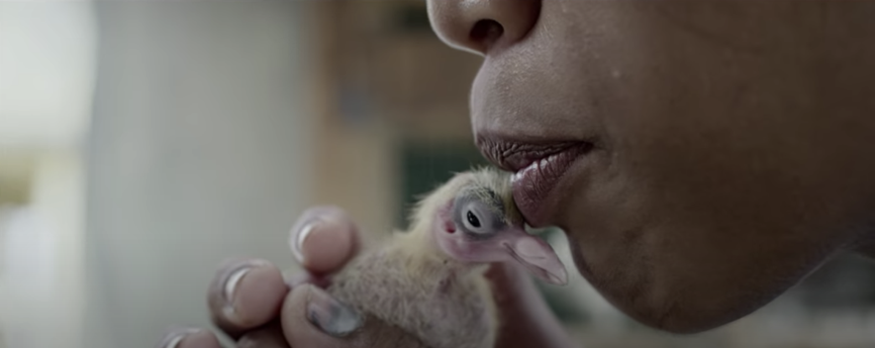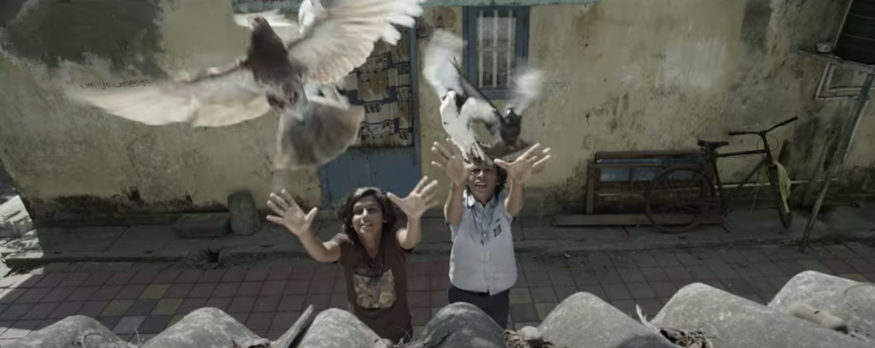Lakshmi Pradeep analyses the human-non-human relationships in the 2017 film, Parava, to talk about an emerging genre of Malayalam cinema: “cli-fi” or climate fiction.
Lakshmi Pradeep

What is the role of the non-human in Malayalam cinema? Let us see with the help of examples from the movie Parava (Rasheed, Unni & Shahir, 2017). The title of the movie itself invokes the significance of parava, the pigeon/bird. This movie is shot in the busy streets of suburban Kochi. Soubin Shahir’s directorial debut revolves around the theme of a pigeon-racing tournament (paravaparathal matsaram) in Mattancherry. It offers glimpses into the director’s life of growing up in this Muslim neighbourhood. It provides us insights into the craft of movie-making through the lens of human and non-human relations.
The plot of the movie opens with two boys, Irshad or Ichappi (Amal Shah) and Haseeb (Govind Pai), whose hobbies are pet-rearing and kite-flying. They are shown as training their pigeons to participate in the upcoming pigeon-racing tournament held in their locality. They spend most of their days and nights on the rooftop with the pigeons. Compared to the competitive spirit of other teams, Ichappi and Haseeb share an affectionate bond with their pigeons.
The story then turns into a flashback of Ichappi’s brother, Shane (Shane Nigam) and his friends. They get involved in a local feud with a bunch of criminals leading to the death of Shane’s friend Imran (Dulquer Salmaan). The twist in the movie occurs during the pigeon racing tournament in the present day. Ichappi’s and Haseeb’s pigeons get stolen. Upon realizing that the thieves are those who killed Imran, Shane decides to fight back. But he is rescued from further bloodshed as his friends and family intervene.
Parava uses the allegorical tale of love, separation, and reunion of the pigeons in order to speak about this neighbourhood. Along with it, the movie opens up possibilities of thinking and living with the non-human. There are many instances in the movie that portrays care for the non-human. For example, there is a sequence where the boys fill their mouths with water and feed the pigeons through their lips (Rasheed, Unni & Shahir, 2017, 00:08:56). The pigeons slowly open their beaks and drink the water. The boys take utmost care while handling the pigeons in and out of the cages. They feed the pigeons with grains as soon as they return from school.

Another striking sequence in the movie is when the boys retrieve one of their pigeons from a harmful captivity. This pigeon is dear to them as it reminds them of Imran. They start removing the pins clipped to the pigeon’s wings and curse the men for their cruelty (01: 47:39). Ichappi slowly blows air into its wings as he removes the pins one by one. They are saddened to see that the wings are torn. They kiss and softly caress the body of the pigeon in a manner to pacify its pain. Their acts of care involve love, labour and attention. As Jerolmack (2013, p.102) writes, men raising pigeons can be seen as a performance of domestic care work that is traditionally associated with the feminine. The examples in this movie show how care for the non-human challenges the gender norms through contrasting images of masculinity—that of Ichappi and Haseeb, and that of the young men around them like Shane.

These sequences in the movie also tell us that the boys share emotional attachment—a sense of corporeal effect—with the non-human. It gets described in a touching scene towards the climax of the movie, when the shocked boys see that their pigeons are missing (01:56:14). Ichappi falls on the ground in dismay as Haseeb starts searching around in vain. Tears roll down their cheeks. They are hopeless and inconsolable at the loss of their pigeons. According to Haraway (2016), domestic pigeons are companions in many ‘naturecultures’ in cities like Cairo, Istanbul, and Berlin. Through the idea of ‘companion species’, Donna Haraway proposes a mode of thinking and living that helps us to engage with non-human species as companions, and not as secondary beings in the biological classification system (Haraway, 2003). In this movie, the pigeons are not only pets, but also belong to that space as much as the humans. Their lives can animate social life in the neighbourhood. The humans and non-humans share an inter-species companionship through coexistence.
Finally, the species in this movie are co-actors; they have performed along with the boys. Sometimes, the camera speaks from the pigeons’ angle. There are several shots that describe the aesthetics of a pigeon’s way of life. The director has mentioned in an interview that the boys and the crew trained in handling pigeons for a year, and were mindful of the pigeons’ needs throughout the shoot. Unlike other mainstream movies, these films decentre humans as plot-drivers. What is the significance of species becoming performers? They can raise important questions of coexistence, and make us capable of envisioning a future of companionship.
In my opinion, this movie, along with a spate of other recent releases like Carbon (2018), Virus (2019), Ottal (2014), and Jallikkattu (2019), herald the emergence of the genre of climate fiction (cli-fi) movies in Malayalam. ‘Cli- fi movies’, a term first coined in 2011 by journalist Dan Bloom, describe movies that are meant to create awareness about the urgency of climate action (Bloom 2019). They narrate stories which are rich in allegories, a central feature of climate films (DeLoughrey, 2019). They aim at cultivating an everyday ecological sensibility which is not necessarily centred around issue-based environmental politics. Hence, we can say that this new genre of movies in Malayalam problematizes our understanding of the social as human-centric. They are a stark reminder of the ‘silent springs’ (Carson 1962) that may follow out of the human destruction of planet Earth.
References
- Bloom, Dan. 2019. ‘Introduction’. Cli-fi Report Global. Retrieved from http://cli-fi.net/index.html
- Carson, Rachel. 1962. Silent Spring. Houghton Mifflin Harcourt.
- DeLoughrey, Elizabeth. 2019. Allegories of the Anthropocene. Durham: Duke University Press. Haraway,
- Haraway, Donna. 2003. The Companion Species Manifesto: Dogs, People, and Significant Otherness. Chicago: Prickly Paradigm Press.
- Haraway, Donna. 2016. Staying with the Trouble: Making Kin in the Chthulucene. Durham: Duke University Press.
- Jerolmack, Colin. 2013. The Global Pigeon. Chicago: The University of Chicago Press.
- Rasheed, Anwar, S. Unni (prod.), and Soubin Shahir (dir.). 2017. Parava [Bird]. India: Anwar Rasheed Entertainment.
About the Author: Lakshmi Pradeep is a research scholar in Anthropology based at South Asian Studies, National University of Singapore. Lakshmi can be contacted at [email protected]

One comment